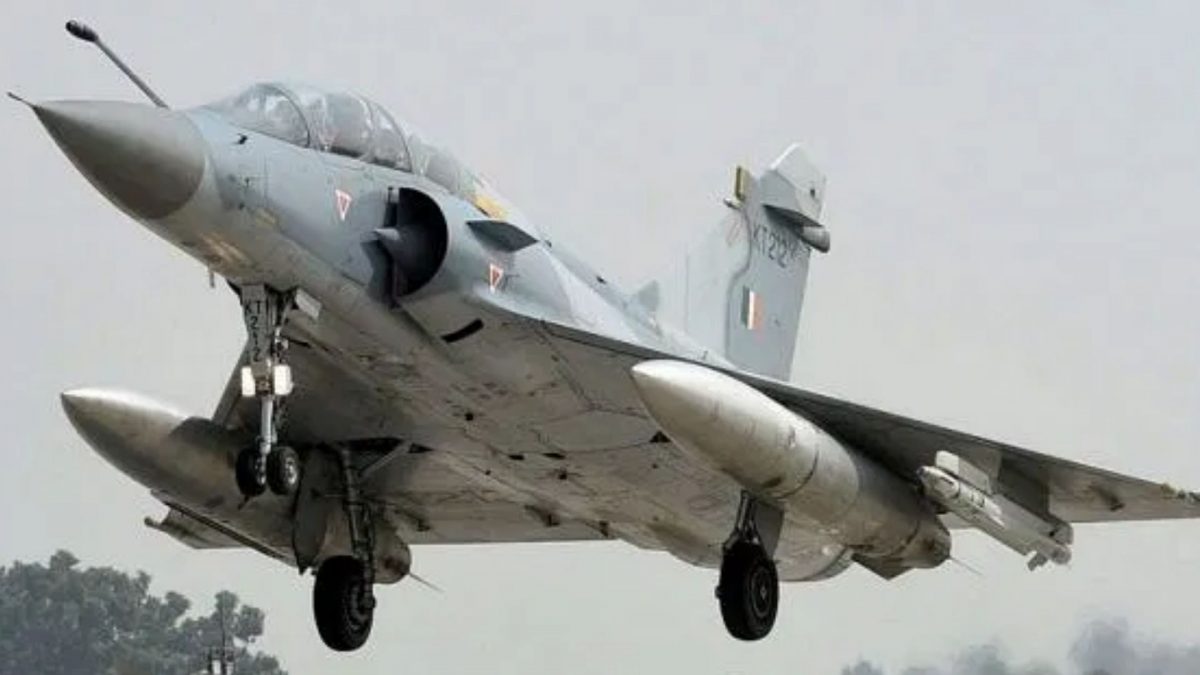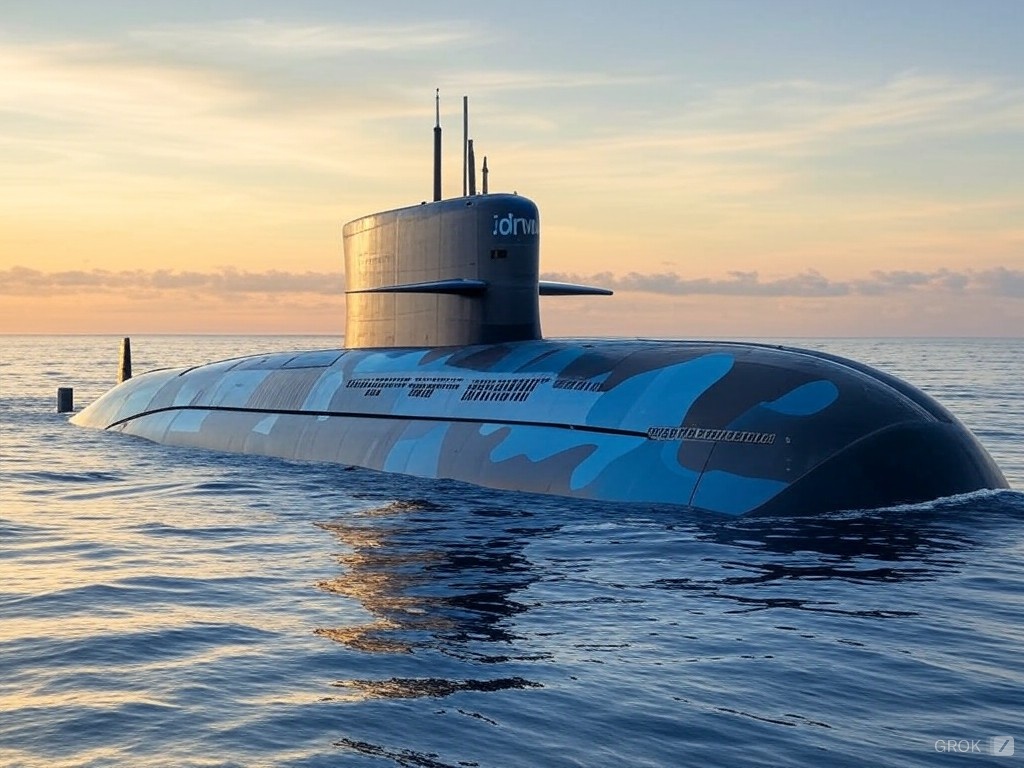Monthly Archives: February 2025
SOURCE: AFI


In a significant showcase of military technology, General Upendra Dwivedi, Chief of the Army Staff (COAS) of the Indian Army, was recently introduced to the Jaguar EBRC (Engin Blindé de Reconnaissance et de Combat), a state-of-the-art 6×6 armored reconnaissance and combat vehicle, during his visit to Paris. This impressive machine is a cornerstone of France’s ambitious Scorpion EBMR (Engin Blindé Multi-Rôles) program, reflecting the future of networked and versatile battlefield solutions.
The Jaguar EBRC, weighing 25 tonnes, is powered by a robust 500-horsepower engine, enabling it to reach speeds of up to 90 km/h and cover a remarkable range of 800 km. Designed for agility and firepower, the vehicle boasts a formidable arsenal. Its primary weapon is a 40mm cannon, complemented by a Hornet Remote Weapon System equipped with a 7.62mm machine gun. For enhanced combat capability, it also carries medium-range missiles and features the innovative Galix self-defense system, capable of deploying both lethal and non-lethal grenades to counter threats.
Continue readingSOURCE: AFI


In a significant step toward modernizing its capabilities, the Indian Army has signed a contract for the procurement of 223 units of the Automatic Chemical Agent Detection & Alarm (ACADA) System. This advanced technology, developed by the Defence Research and Development Establishment (DRDE), a Gwalior-based laboratory of the Defence Research and Development Organisation (DRDO), will be produced by M/s Larsen & Toubro Ltd (L&T), a designated Technology Transfer (ToT) holder and production agency for the ACADA system. The deal marks a milestone in India’s pursuit of self-reliance in critical defense technologies.
The ACADA system is designed to detect and provide early warnings against chemical warfare (CW) agents and toxic industrial chemicals (TICs), bolstering the Indian Army’s preparedness in Chemical, Biological, Radiological, and Nuclear (CBRN) defense. Leveraging twin-tube Ion Mobility Spectrometry (IMS) technology, the system offers continuous monitoring and rapid detection capabilities, making it an essential tool for enhancing operational readiness in contested environments. Its induction is expected to strengthen the Army’s ability to respond to CBRN threats, as well as support disaster relief efforts where chemical hazards may be a concern.
Continue readingSOURCE: AFI


In a move that has sent ripples through the global defense industry, the United States has signaled its intent to officially veto the sale of the General Electric F414-GE-39E engine, a critical component of the Saab Gripen E fighter jet, to the Fuerza Aeroespacial Colombiana (FAC), Colombia’s air force. This decision, aimed at nudging Colombia toward purchasing American-made Lockheed Martin F-16 jets instead, has sparked debate about its broader implications—particularly for India’s Tejas MkII, which relies on a variant of the same engine. With the U.S. wielding significant influence over the export of its technology, questions are mounting about whether this veto could cast a shadow over India’s ambitions to market the Tejas MkII internationally, especially to nations aligned with or contested by American interests.
The F414-GE-39E, a derivative of the widely used F414 family, powers the advanced Gripen E, a lightweight, multi-role fighter developed by Sweden’s Saab. Colombia had been considering the Gripen E as part of its effort to modernize its aging fleet, but the U.S. veto effectively scuttles that option by denying access to the engine, a move seen as leveraging American control over key aerospace components to secure a strategic sale.
Continue readingSOURCE: AFI


Union Defence Minister Rajnath Singh recently announced a significant milestone in India’s journey toward self-reliance in defense manufacturing, revealing that the country has achieved an impressive 88 percent self-sufficiency in ammunition production. The statement, made during a recent address, underscores the strides made by India’s defense sector under the government’s ambitious “Make in India” initiative.
Looking ahead, the Defence Minister outlined an even bolder vision for the sector, stating that India aims to achieve a defense production target of ?50,000 crore by 2029. This ambitious goal signals the government’s intent to not only sustain but accelerate the momentum of indigenization. Singh’s announcement aligns with broader efforts to transform India into a global hub for defense manufacturing, with an emphasis on both meeting domestic needs and boosting exports.
Continue readingSOURCE: AFI


A tweet from X handle Ammar Solangi, who goes by @fake_burster and identifies as a “Freelance Journalist” and “Social Media Activist,” has ignited a firestorm of speculation and rebuttals online. Solangi posted a sensational claim: “SU-57 of Indian Air Force, enroute to Moscow, made an unauthorized appearance in Iranian air space, that led to force landed by Iran’s Air defence / Air Force. He also claimed that Indian defence minister had to apologies to IRGC. The aircraft was allowed to fly after formal apology from Indian defense, ministry, and the crew.” The post, lacking any verifiable evidence, quickly drew attention—and skepticism—from Indian social media users.
The Sukhoi Su-57, Russia’s fifth-generation stealth fighter, had recently made headlines at Aero India 2025, held from February 10-14 at Yelahanka Air Force Station in Bengaluru. Following the airshow, reports confirmed that a Russian Su-57—identified as “Blue 054″—departed India for Russia, with a refueling stop at Iran’s 9th Tactical Fighter Base in Bandar Abbas on February 19. Satellite imagery and videos circulating online corroborated its presence there, aligning with the jet’s known range of approximately 3,500 kilometers, insufficient for a direct flight from Bengaluru to Russia’s Akhtubinsk Air Base without a layover. However, Solangi’s claim that the jet belonged to the Indian Air Force (IAF) and was forcibly intercepted by Iran has raised eyebrows, given that India does not operate the Su-57.
Continue readingSOURCE: IANS
)

India on Wednesday marked the sixth anniversary of the Balakot airstrike, carried out by the Indian Air Force (IAF) in response to the deadly Pulwama terror attack.
The airstrike was part of India’s campaign against cross-border terrorism and manifested the country’s willingness to take decisive action against terror infrastructure in Pakistan. The airstrike carried out in the very early hours of February 26, 2019, was a ‘punitive strike’ on a Jaish-e-Mohammed (JeM) facility in Pakistan Occupied Kashmir (PoK) in which Balakot-based terror camp was destroyed.
Continue readingSOURCE: RAUNAK KUNDE / NEWS BEAT / IDRW.ORG


India’s ambitious Advanced Medium Combat Aircraft (AMCA) program, aimed at delivering the nation’s first indigenous fifth-generation stealth fighter, is approaching a pivotal milestone: the selection of an engine partner. The Indian government, through the Defence Research and Development Organisation’s (DRDO) Gas Turbine Research Establishment (GTRE), is engaged in high-stakes negotiations with three global aerospace giants—General Electric (GE) from the United States, Rolls-Royce from the United Kingdom, and Safran from France—to co-develop a cutting-edge engine for the AMCA. With a possible decision slated by the end of 2025, this choice will shape the fighter’s performance, India’s defense self-reliance, and its strategic alignments for decades to come.
DRDO Chief Dr. Samir V. Kamat, speaking at Aero India 2025, confirmed the ongoing talks, stating, “We are in discussions with GE, Rolls-Royce, and Safran for the joint development and manufacturing of the AMCA engine. A decision is likely by the end of this year.” This timeline, echoed reports from idrw.org, reflects India’s urgency to finalize a partner and kickstart development, targeting engine trials by 2033 and production by 2035.
Continue readingSOURCE: RAUNAK KUNDE / NEWS BEAT / IDRW.ORG


The Defence Research and Development Organisation (DRDO) of India is embarking on an ambitious project to integrate Directed Energy Weapons (DEWs) into its aerial arsenal by developing a specialized DEW Pod for helicopters. This initiative aims to create a self-contained system that encapsulates all necessary subsystems, offering a new dimension to helicopter combat capabilities.
The DEW pod is envisioned as a multi-functional, integrated capsule containing all the necessary subsystems for seamless operation. The design aims to simplify integration while maximizing effectiveness. The following components form the backbone of this revolutionary system.
Continue readingSOURCE: RAUNAK KUNDE / NEWS BEAT / IDRW.ORG


The Defence Research and Development Organisation (DRDO) has laid out an ambitious vision for the future of the Indian military, focusing on the development of a humanoid robot army. These robots, designed to carry firearms and operate under human command, aim to participate in high-risk combat scenarios, thereby reducing the exposure of human soldiers to life-threatening situations.
According to insights shared with idrw.org, the Indian Army is showing a keen interest in integrating more robotics into its operational framework to alleviate the physical and psychological stress on its personnel. However, the specifics regarding what the Army expects from these humanoid units remain undefined. Current discussions between the DRDO, the Indian Army, and various academic institutions are still in the exploratory phase, with a clear understanding that this futuristic project could take anywhere from 15 to 20 years to reach operational deployment.
Continue readingSOURCE: AFI


India’s naval modernization has hit a rare snag—not from adversaries, but from within its own ranks. Vice Admiral (Retd) KN Sushil, a seasoned submariner and former Commander-in-Chief of the Southern Naval Command, has publicly challenged the Defence Research and Development Organisation’s (DRDO) lead in designing submarines under Project-76. Speaking to News9 Plus Editor Sandeep Unnithan Sushil asked a pointed question: why is DRDO crafting a new submarine when the Navy’s own Submarine Design Group (SDG), nestled within the Directorate of Naval Design (DND), is fully equipped to do the job? He further questioned the need for design approval if DRDO claims such capability, igniting a debate that cuts to the heart of India’s defense ecosystem.
Project-76 is DRDO’s bold bid to deliver six next-generation electric-conventional (diesel-electric) submarines, with Cabinet Committee on Security (CCS) approval expected by April 2025. Touted as 90-95% indigenous, these 3,000-4,000-ton boats promise advanced features DRDO’s phosphoric acid-based Air-Independent Propulsion (AIP), lithium-ion batteries, pump-jet propulsion, and possibly vertical launch systems (VLS) for cruise missiles. The agency aims to finalize the design by 2028, with the first hull afloat by 2033-34—a timeline synced with the Navy’s urgent need to counter China’s 40-plus conventional subs and Pakistan’s growing fleet.
Continue readingSOURCE: AFI


Cingularity Aerospace, based in Bangalore, has introduced an innovative solution for military training with their new Tow Body Haulers, dubbed “Pratyaksha.” Designed as a Slow Speed Soft Reusable Target, this system aims to provide realistic, safe, and cost-effective training for air-to-air engagements.
The tow body comprises a cylindrical chute, measuring 5 meters in length and 3 meters in diameter, painted in daylight orange for visibility, ensuring it can be easily spotted during training exercises.
Continue readingSOURCE: AFI


The People’s Liberation Army Air Force (PLAAF) has ramped up the testing phase of its new J-35A stealth fighter, signaling a significant advancement in China’s aerial combat capabilities. This development has broader implications, particularly for the naval version, soon to be designated as the J-35C, and for international partners like the Pakistan Air Force (PAF).
The PLAAF’s decision to speed up trials of the J-35A indicates a strategic focus on integrating this new stealth fighter into its fleet. With the J-20 already in full-speed production, the urgency for the J-35A might be less about immediate operational needs and more about expanding the PLAAF’s stealth capabilities.
Continue readingSOURCE: AFI


In a significant advancement for tactical gear, Delhi-based ArmasenTactical has introduced its latest High Cut Ballistic Helmet Cover, featuring a unique detachable counterweight/battery pack system. This innovative accessory is set to redefine how tactical operators manage their gear for enhanced comfort and functionality.
Armasen Tactical’s new helmet cover is designed to integrate seamlessly with high-cut ballistic helmets, offering operators a blend of comfort, customization, and utility. Here’s what makes this product stand out.
Continue readingSOURCE: IDRW.ORG


Aviation industrial expert Mahesh Hegde has raised concerns regarding the rationale behind the development of the RTA-90 aircraft based on turboprop engines, given the limited demand for such aircraft in India. Speaking to idrw.org, Hegde emphasized that market projections from major aerospace manufacturers indicate a marginal requirement for turboprop-powered regional jets in India over the next two decades.
According to Hegde, procurement projections by all major aerospace vendors that manufacture commercial jets suggest that only 6 percent of the total planned aircraft procurement by Indian airline operators in the next 20 years will consist of turboprop-powered regional jets. Instead, the market will be dominated by narrowbody jets, with a particular preference for aircraft in the A321 class, which are powered by high-bypass turbofan engines rather than turboprop engines.
Continue readingSOURCE: IDRW.ORG


Bengaluru-based NewSpace Research and Technologies (NRT) is once again pushing the boundaries of India’s aerospace and defense innovation with the Ishuk—a miniaturized glide device that transforms a basic aerial iron bomb into a precision-guided powerhouse. Unveiled as a marvel of aerodynamics and engineering, this compact system promises to revolutionize kinetic strikes with its pinpoint accuracy, exceptional range, and adaptability across multi-rotor and fixed-wing platforms. Designed for steep, direct attacks with minimal drag on its carrier aircraft, Ishuk signals NRT’s ascent as a trailblazer in unmanned aerial systems (UAS)—and a potent force multiplier for India’s armed forces.
At its core, Ishuk is a retrofit genius. It takes a standard unguided “dumb” bomb—typically a low-cost, high-explosive workhorse—and outfits it with a high-precision guidance and control kit. The result? A glide bomb that rivals costlier precision munitions in accuracy and lethality, without the hefty price tag. With a low radar cross-section and a high glide ratio, Ishuk extends the bomb’s range far beyond traditional free-fall limits, allowing strikes from safer standoff distances. Weighing next to nothing compared to its payload, it ensures the carrier—be it a drone or manned aircraft—suffers minimal performance penalty, a critical edge in dynamic combat zones.
Continue reading